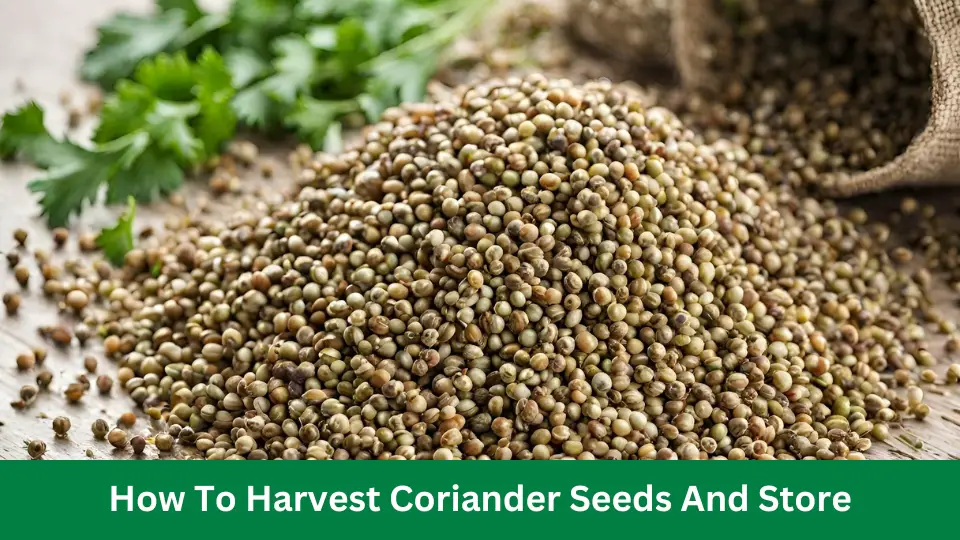To harvest coriander seeds, wait until the plant flowers and produce dry, brown seed pods, then cut the stems and hang them upside down in a paper bag until the seeds fall out. Coriander, also known as cilantro or Chinese parsley, is a versatile herb commonly used in various cuisines around the world.
Besides its fresh leaves, coriander seeds have a distinct flavor and are used as a spice in cooking. Harvesting coriander seeds is a simple process that involves waiting for the plant to flower and produce dry seed pods. Once the pods turn brown and dry, the stems can be cut and hung upside down in a paper bag.
As the plant dries, the ripe seeds will fall out, ready to be collected and used in your favorite dishes. We will discuss the steps to properly harvest coriander seeds and some tips to ensure a successful harvest.
Growing Coriander For Seed
Growing coriander from seed is a rewarding endeavor that allows you to enjoy the fresh leaves and aromatic spice all from one plant. By focusing on seed production, you can ensure a constant supply of coriander seeds for culinary uses and even for next year’s planting.
This article explores the essentials of growing coriander from seed. This includes choosing the right variety, understanding the ideal growing conditions, and planting and spacing considerations.
Choosing The Right Variety For Seed Production
When it comes to growing coriander for seed, selecting the appropriate variety is crucial. Not all coriander varieties are well-suited to seed production; some are primarily grown for their leaves. Choosing a variety specifically bred for high seed yield and quality is recommended for seed production purposes.
Ideal Growing Conditions
Providing the plant with ideal growing conditions is essential for a successful coriander seed harvest. Coriander thrives in cool climates and prefers well-drained soil rich in organic matter. It is a versatile herb that can be cultivated in full and partial sun, although some afternoon shade can prevent the plant from bolting prematurely.
The optimum temperature range for coriander growth is between 50°F and 85°F (10°C to 29°C). Anything lower than 50°F (10°C) can slow down growth, while temperatures above 85°F (29°C) can cause the plant to bolt, focusing its energy on flower and seed production rather than leaf development. Adequate moisture is also crucial, as drought stress can cause premature bolting and affect seed quality.
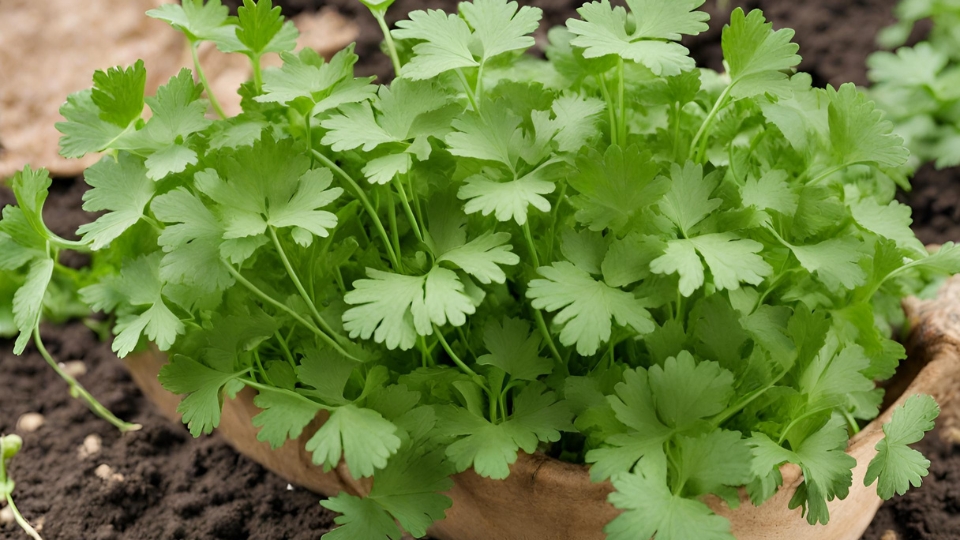
Planting And Spacing Considerations
When planting coriander from seed, it is essential to ensure proper spacing to allow each plant to reach its full potential. The recommended spacing for coriander plants is around 6 to 8 inches (15 to 20 cm) apart, with rows spaced at least 12 to 15 inches (30 to 38 cm) apart. This spacing allows development and prevents resource competition.
Coriander seeds can be sown directly in the garden after frost danger has passed. Sow the seeds about ¼ to ½ inch (0.6 to 1.3 cm) deep and keep the soil consistently moist until germination, which typically takes 7 to 10 days. Thin the seedlings to the desired spacing once they have established their first true leaves.
It is worth noting that coriander plants have taproots, so transplanting them can be challenging. As a result, it is generally recommended to sow the seeds directly in the location where they will grow.
In conclusion, growing coriander for seed production requires careful consideration of the variety, ideal growing conditions, and proper planting and spacing. By following these guidelines, you can ensure a bountiful harvest of coriander seeds for all your culinary needs.
When To Harvest Coriander Seeds
Growing your coriander is a rewarding experience, and harvesting the seeds is an essential part of the process. Knowing when to harvest coriander seeds ensures you get your crop’s best flavor and potency. This article discusses when to harvest coriander seeds and provides valuable tips to ensure a successful harvest.
Identifying Seed Maturity
Before diving into the signs of harvest readiness, it is crucial to identify when coriander seeds are mature enough for harvesting. Coriander seeds can be matured by observing their physical characteristics and timing them correctly.
Coriander seeds are tiny and green in the early stages of seed formation. As they mature, the color changes to brownish-yellow. Mature seeds are complex, highly aromatic, and prominently curved. By observing these physical characteristics, you can quickly identify the maturity of coriander seeds.
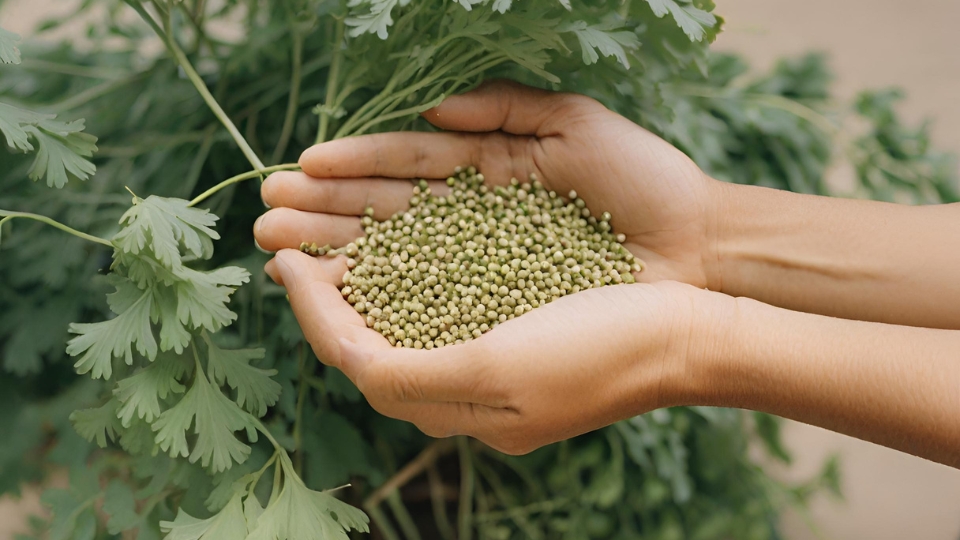
Coriander seed harvest timing is crucial for optimum flavor and aroma. Coriander plants typically produce seeds 3-4 months after sowing. The best time to harvest coriander seeds is when they are fully mature and dry on the plant. Waiting too long may cause seeds to drop and scatter, yielding less.
Signs Of Readiness For Harvest
Once you have identified the maturity of coriander seeds, it’s time to look out for the signs of readiness for harvest. The following indicators will help you determine if your coriander seeds are ready to be harvested:
- Drying and Browning: As the seeds mature, the coriander plant’s stems and leaves dry and turn brown. This is a clear sign that the seeds are nearing readiness for harvest.
- Fragrance: Mature coriander seeds have a distinct and intense aroma that wafts through the air. When you notice the fragrance becoming stronger, it’s a good indication that the seeds are ready to be harvested.
- Easy Seed Removal: When the seeds are fully mature, they become loose and easily detach from the plant when touched. If the seeds are still firmly attached, it’s a sign that they need more time to mature.
By closely monitoring these signs, you can ensure that you harvest coriander seeds at their peak flavor and potency.
Harvesting coriander seeds at the right time is essential to enjoy the intense aroma and flavor that coriander is known for. By identifying the seed maturity through physical characteristics and timing and monitoring the signs of readiness for harvest, you can achieve a successful coriander seed harvest.
Stay tuned for our following guidelines, where we will discuss the best harvesting techniques to preserve the quality of your coriander seeds.
Harvesting Techniques And Tools
Harvesting coriander seeds ensures optimal flavor and quality in your spice rack. This article delves into the techniques and tools you can use to harvest coriander seeds effectively. We cover everything from hand-picking and mechanical harvesting to the best time to harvest coriander seeds.
Hand-picking Versus Mechanical Harvesting
You have two main options when harvesting coriander seeds: hand-picking or mechanical harvesting. Each method has its benefits and considerations depending on your resources and requirements.
Hand-picking coriander seeds allows for more precision and control over the process. It is ideal for small-scale operations and home gardeners who value connecting with the harvest. By hand-picking, you can selectively harvest ripe seeds as they mature, ensuring the highest quality for your spice collection.
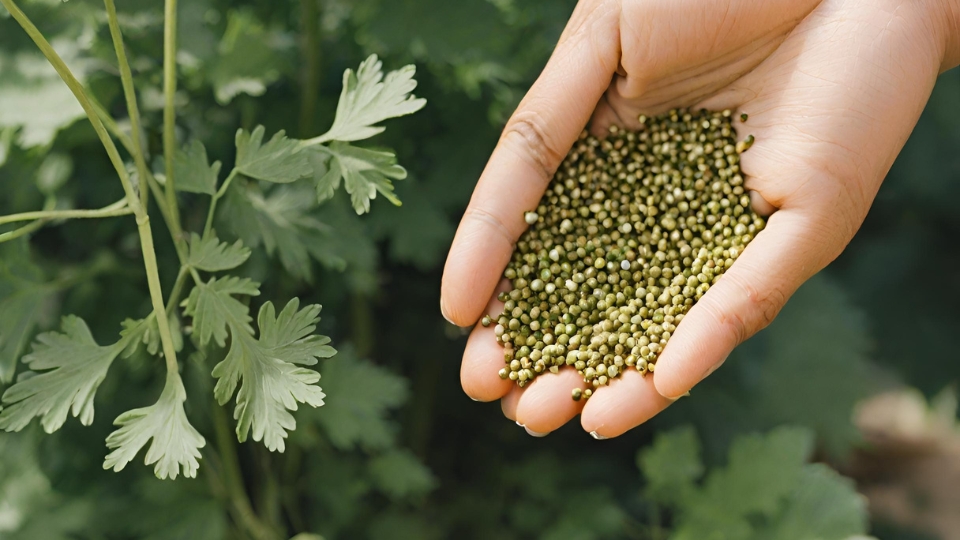
On the other hand, mechanical harvesting offers efficiency and speed, making it suitable for larger farms and commercial operations. This method involves using machinery like seed harvesters to cut down entire coriander plants and strip the seeds from them. Although it lacks the personal touch of hand-picking, mechanical harvesting significantly reduces labor and time requirements.
Tools To Simplify The Process
Several tools can come in handy to simplify the coriander seed harvesting process. These tools assist in hand-picking and mechanical harvesting methods, enhancing productivity and ease of use.
Hand-picking Tools
- Gardening gloves: Protect your hands from prickles and potential allergic reactions.
- Garden shears: Use sharp shears to harvest coriander stalks efficiently.
- Buckets or containers: Collect the harvested coriander seeds for further processing.
Mechanical Harvesting Tools
- Seed harvesters: These machines are designed specifically for coriander seed harvesting, cutting down the plants, and separating the seeds.
- Tractor-mounted equipment: Attachments like seed harvesters or brush cutters can be mounted on tractors to enhance mechanical harvesting.
Best Time To Harvest Coriander Seeds
The best time to harvest coriander seeds is when they have fully ripened on the plant. Watch the plants as the flowers transition into seeds to determine the right time. Wait until the seeds turn brown and begin to loosen from the plant. The coriander seeds are most flavorful and ready for harvesting at this stage. Harvesting too early may result in immature and less potent seeds.
Remember: Harvest coriander seeds in the early morning or late evening when temperatures are more relaxed to achieve the best flavor profile and preserve the seeds’ aromatics.
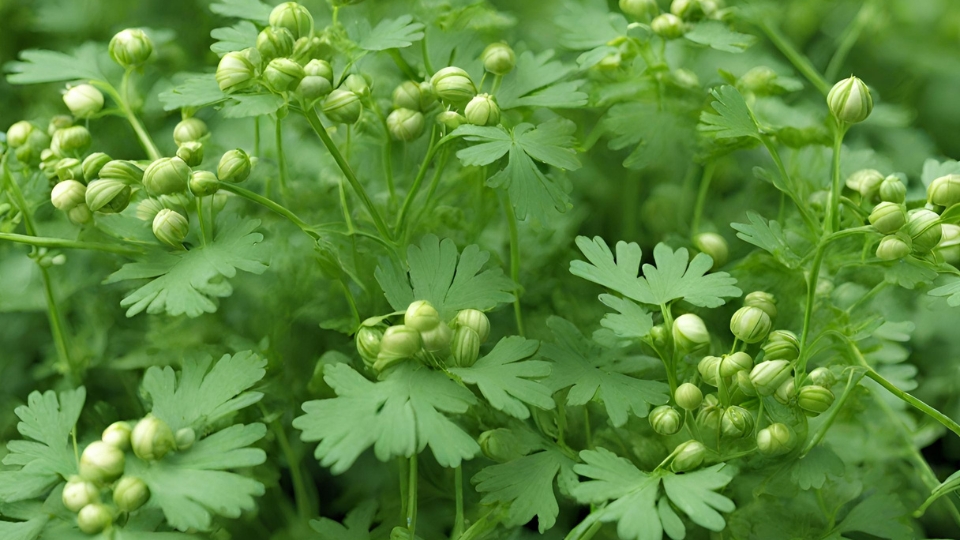
Preserving Seed Integrity During Harvest
Preserving Seed Integrity During Harvest is crucial for ensuring the quality and purity of coriander seeds. Handling the seeds with care and employing specific techniques can help prevent damage and maintain the integrity of the seeds. To prevent seeds from becoming contaminated, we will explore the best practices for harvesting coriander seeds.
Handling Seeds To Prevent Damage
Proper handling techniques play a significant role in preserving the integrity of coriander seeds during harvest. By following these steps, you can minimize the risk of damage to the seeds:
- Use sharp and clean tools: Ensure that the harvesting tools, such as shears or a sickle, are sharp and free from residue or contaminants. This reduces the chances of bruising or crushing the seeds during harvesting.
- Harvest when dry: Wait for the coriander plants to be dry before harvesting. Harvesting them when the seed heads are fully mature and dry minimizes the risk of damaging the seeds.
- Handle with care: Gentle handling is crucial to prevent seed damage. Avoid applying excessive pressure or force while cutting or threshing the seed heads. A delicate touch will help preserve the seed’s integrity.
- Wear gloves: To maintain seed purity and prevent contamination, wear clean gloves during harvesting. This will prevent any transfer of impurities or foreign materials onto the seeds.
- Collect in clean containers: Ensure the containers used for collecting the coriander seed heads are clean and free from any dirt, debris, or previous harvest residue. This prevents contamination and helps maintain the integrity of the seeds.
Techniques To Maintain Purity
In addition to careful handling, several techniques can be employed to maintain the purity of coriander seeds. These techniques include:
- Isolation: When growing coriander plants for seed production, keeping them isolated from other varieties or plants that may cross-pollinate is essential. Isolating the plants reduces the chances of seed contamination or loss of purity.
- Inspect for quality: Before harvesting, inspect the seed heads for any signs of disease, pests, or low-quality seeds. By removing any compromised seed heads, you can maintain the overall purity of the harvest.
- Thorough drying: Once the seed heads are harvested, ensure they are thoroughly dried before threshing. Proper drying minimizes the risk of mold or seed damage during storage.
- Storage conditions: Store the coriander seeds in a cool, dry, dark place to maintain their quality and prevent degradation. Avoid exposing the seeds to direct sunlight or moisture, as these conditions can lead to mold or loss of viability.
- Labeling and organization: Labeling the harvested seeds with batch or variety information helps maintain seed traceability and prevent mix-ups. Systematically organizing the seeds ensures easy access and minimizes the risk of misplacing or losing seeds.
Following these guidelines for handling and preserving coriander seeds during harvest can ensure seed integrity and quality. Implement these best practices to reap the benefits of high-quality, pure coriander seeds for your culinary and gardening endeavors.
Post-harvest Seed Processing
Regarding harvesting coriander seeds, post-harvest seed processing is crucial in ensuring the seeds are of top-notch quality. Post-harvest processing involves various steps that help dry, threshing, and separating the seeds from the chaff. These steps are essential to preserve the coriander seeds’ flavor, aroma, and overall quality.
Drying Methods For Coriander Seeds
Properly drying coriander seeds is essential to prevent moisture retention, which can lead to mold growth and quality deterioration. There are several methods you can use to dry coriander seeds:
- Air Drying: This is the simplest method where you spread the harvested coriander seeds on a clean and dry surface, preferably in a single layer. Allow them to air dry in a well-ventilated area, away from direct sunlight. Remember to turn them occasionally to ensure even drying. The process may take a few days to a week, depending on the humidity level.
- Oven Drying: If you are in a hurry or live in an area with high humidity, oven drying can be a quicker alternative. Spread the coriander seeds on a baking sheet and place them in the oven at a low temperature, typically around 100 degrees Celsius. Keep the oven door slightly open to allow moisture to escape. Monitor the seeds closely to prevent burning, and turn them occasionally for even drying.
- Dehydrator: Using a dehydrator is another effective method for drying coriander seeds. Follow the manufacturer’s instructions to set the temperature and time required for drying. Spread the seeds on the dehydrator trays in a single layer, ensuring good air circulation. Check the seeds periodically until they are scorched.
Threshing And Separating Seeds From Chaff
Once the coriander seeds are thoroughly dried, the next step is to separate them from the chaff. The chaff refers to the protective outer covering of the seeds and other plant debris. Here are some methods you can use for threshing and separating coriander seeds:
- Manual/Hand Rubbing: This method involves rubbing the dried coriander stalks or bundles against each other to loosen the seeds. You can do this by placing the stalks in a bag or a clean cloth and gently crushing them to release the seeds. Once the seeds are separated, use a sieve to remove any remaining chaff.
- Threshing Machine: A threshing machine can separate the seeds from the chaff for larger-scale processing. The machine works by agitating the stalks or bundles to remove the seeds. After threshing, the seeds and chaff are separated using a sieve or a winnowing machine.
- Winnowing: This traditional method involves tossing the mixed seeds and chaff into the air using a shallow tray or basket. The wind or a fan blows away the lighter chaff while the heavier seeds fall back into the tray. Repeat the process until most of the chaff is removed.
In conclusion, proper post-harvest seed processing is essential for harvesting coriander seeds. Drying the seeds using air, ovens, or dehydrators helps preserve their quality. Threshing and separating the seeds from the chaff can be done manually, with a threshing machine, or through winnowing. These post-harvest processes ensure the coriander seeds are ready for storage and use.
Storing Harvested Coriander Seeds
Storing harvested coriander seeds properly is essential to preserve their flavor and freshness. By following the right storage techniques, you can enjoy the aromatic essence of these seeds in your culinary creations for a longer period. This section will explore the ideal storage conditions and provide some long-term viability tips to ensure your harvested coriander seeds remain in top-notch condition.
Ideal Storage Conditions
Storing the quality and flavor of your harvested coriander seeds under suitable conditions is crucial. Here are the ideal storage conditions for coriander seeds:
- Airtight containers: Store your coriander seeds in airtight containers to prevent moisture and air from affecting their quality. Mason jars, glass containers, or resealable bags can keep the seeds fresh.
- Cool temperature: Keeping coriander seeds at a cool temperature helps to prolong their shelf life. Aim for a storage area below 70°F (21°C) to maintain optimal freshness.
- Avoid sunlight exposure: Direct sunlight can cause coriander seeds to lose their essential oils, flavor, and potency. Therefore, storing them in a dark and cool place is crucial.
- Low humidity: Humidity can lead to mold growth and spoilage of your coriander seeds. Ensure the storage area has low humidity to maintain the seeds’ quality. You may also consider using desiccants or moisture absorbers to control moisture levels.
By following these ideal storage conditions, you can prolong the freshness and potency of your harvested coriander seeds.
Long-term Viability Tips
To extend the viability of your coriander seeds for the long term, consider the following tips:
- Properly dry the seeds: Thoroughly dry your coriander seeds before storing them. This helps to prevent mold formation and ensures a longer shelf life. Spread the harvested seeds in a single layer on a clean, dry surface, allowing them to air dry for a few days.
- Label and date: When storing coriander seeds, it’s crucial to label the containers and include the harvest date. This way, you can easily keep track of their freshness and use them promptly.
- Avoid strong odors: Coriander seeds quickly absorb surrounding odors, which can affect their flavor. Store them away from strong-smelling substances such as spices, onions, or cleaning agents to avoid flavor contamination.
- Check for rancidity: Check your stored coriander seeds regularly for any signs of rancidity or deterioration. If you notice a musty or off-putting smell, it’s best to discard them and replace them with fresh ones.
By implementing these long-term viability tips, you can ensure that your harvested coriander seeds maintain their quality and potency for an extended period, allowing you to enjoy their delightful flavor in your favorite dishes.
Preventing Common Harvest Issues
Harvesting coriander seeds can be a rewarding experience, especially when you have taken the necessary steps to prevent common issues that can affect the quality of your harvest. Proactively managing pests and diseases can ensure a successful coriander seed harvest.
In this article, we will explore practical methods for pest management during growth and disease control, both pre and post-harvest.
Pest Management During Growth
Pests can wreak havoc on coriander plants if left unchecked. Implementing an effective pest management strategy during growth is crucial to prevent infestations and minimize crop damage. Here are some essential tips to keep those pesky pests at bay:
- Maintain regular inspection of plants to identify and address pest infestations early on.
- Introduce beneficial insects, such as ladybugs and lacewings, natural predators of common coriander pests like aphids.
- Use companion planting techniques to repel or confuse pests. For example, planting coriander alongside marigolds can deter harmful insects.
- Consider organic pest control methods, including neem oil or garlic spray, which are safe and environmentally friendly.
Disease Control Pre And Post-harvest
Coriander plants are susceptible to various fungal and bacterial diseases that can significantly impact the quality of the harvest. Taking proactive measures to control and prevent diseases is vital for a successful coriander seed harvest. Here are some preventative measures to consider:
- Rotate coriander crops with unrelated plants to break the disease cycle.
- Ensure good ventilation and sunlight for coriander plants to reduce humidity, preventing fungal infections.
- Avoid over-watering, as excessive moisture can create a favorable environment for the growth of pathogens.
- Regularly scout for signs of disease, such as leaf spots or wilting, and promptly remove affected plants to prevent the spread.
- Practice proper sanitation by cleaning garden tools and equipment to prevent cross-contamination.
By implementing these proactive measures for pest management and disease control, you can maximize the health and yield of your coriander seed harvest. Protecting your plants from common issues allows you to enjoy the delicious flavor and aromatic properties of homegrown coriander seeds in various culinary creations.
Maximizing Coriander Seed Yields
When it comes to growing coriander, there’s something undeniably satisfying about harvesting your coriander seeds. Not only do they add a burst of flavor to your dishes, but they also make a delightful addition to your herb collection. Following some best practices and timing techniques is essential to maximize your coriander seed yields.
This post will explore the strategies for a bountiful harvest and the importance of timing successive plantings to ensure a continuous yield.
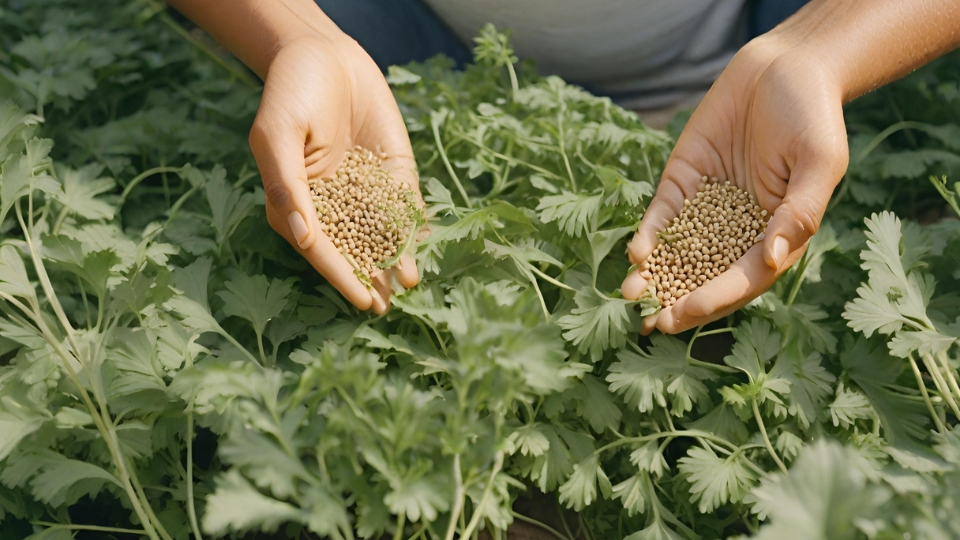
Best Practices For A Bountiful Harvest
To achieve a bountiful harvest of coriander seeds, it’s essential to follow these best practices:
- Choose the right variety: The appropriate coriander variety is crucial in determining seed yield. Opt for varieties specifically bred for seed production, such as ‘Leisure’ or ‘Moroccan,’ to ensure optimum results.
- Provide ample sunlight: Coriander thrives in sunny locations. Ensure your plants receive at least six hours of direct sunlight daily to promote healthy growth and increase seed production.
- Optimize soil fertility: Coriander grows best in well-draining, fertile soils. Before planting, amend your soil with organic matter to improve its fertility and drainage capabilities.
- Maintain proper spacing: Avoid overcrowding your coriander plants, which can hinder air circulation and promote disease development. Aim for approximately 6-8 inches spacing between each plant to allow for adequate growth and seed production.
- Implement regular watering: Coriander plants require consistent moisture. Water regularly, aiming to keep the soil evenly moist but not waterlogged. Avoid overhead watering to reduce the risk of fungal diseases.
- Control pests and diseases: Be vigilant and promptly address any pest or disease issues. Regularly inspect your plants and employ appropriate measures, such as organic insecticides or homemade remedies, to prevent damage to your coriander crop.
Timing Successive Planting For Continuous Yield
In addition to following best practices, timing successive plantings is key to ensuring a continuous yield of coriander seeds. By staggering your plantings, you can extend the harvest period and enjoy a fresh supply of coriander seeds throughout the growing season. Here are some steps to consider:
- Plan your planting schedule: Determine the desired duration of your coriander seed harvest. Consider the average maturity period of your chosen coriander variety, typically around 60-75 days from sowing to seed maturity.
- Sow seeds in batches: Divide your coriander seed sowing into batches, staggering them at regular intervals. This can be done every few weeks to ensure a continuous supply of fresh coriander leaves and seeds.
- Keep track of dates: Maintain a gardening calendar or use a digital gardening app to keep track of planting dates, allowing you to monitor the growth progress and anticipate the next round of sowing for a continuous yield.
- Harvest at the right time: Be attentive to the signs of seed maturity, such as the appearance of flowers turning into dried seed heads and the gradual browning and drying out of the stems. Harvest the seed heads when fully dry, ensuring they have reached maximum maturity for optimal flavor and storage potential.
By carefully implementing these practices and timing successive plantings, you can maximize your coriander seed yields and enjoy a plentiful supply throughout the growing season. Remember, patience and attentiveness are key when harvesting coriander seeds—yielding the rewards of a flavorful and aromatic herb to elevate your culinary creations.
Frequently Asked Questions For Harvest Coriander Seeds
How Long Does It Take For Coriander Seeds To Mature?
Coriander seeds typically take about 3 to 4 months to mature from planting to harvest.
Can You Harvest Coriander Seeds From The Plant?
Yes, you can harvest coriander seeds from the plant. Once the plant produces flowers and those flowers turn brown, you can cut the entire plant and hang it upside down in a paper bag to collect the seeds as they dry.
How Do You Know When Coriander Seeds Are Ready To Harvest?
Coriander seeds are ready to harvest when the plant produces flowers that turn brown. This usually happens about 3 to 4 months after planting.
What Is The Best Time To Harvest Coriander Seeds?
The best time to harvest coriander seeds is when the plant produces flowers that have turned brown. Harvesting should be done on a dry day to ensure the seeds are dry and mature.
Conclusion
Coriander seeds are a versatile ingredient that uniquely flavors various dishes. Harvesting coriander seeds can be a rewarding and cost-effective way to incorporate this spice into your cooking. By following the appropriate techniques and ensuring the seeds are fully ripe, you can enjoy the benefits of freshly harvested coriander seeds in your culinary creations.
Whether you’re a seasoned gardener or a beginner, harvesting coriander seeds can be a fun and educational experience. So, don’t hesitate to try it out and enhance your cooking with the delicious taste of homegrown coriander seeds.
Video Source: https://www.youtube.com/watch?v=3RwxOj6551k

